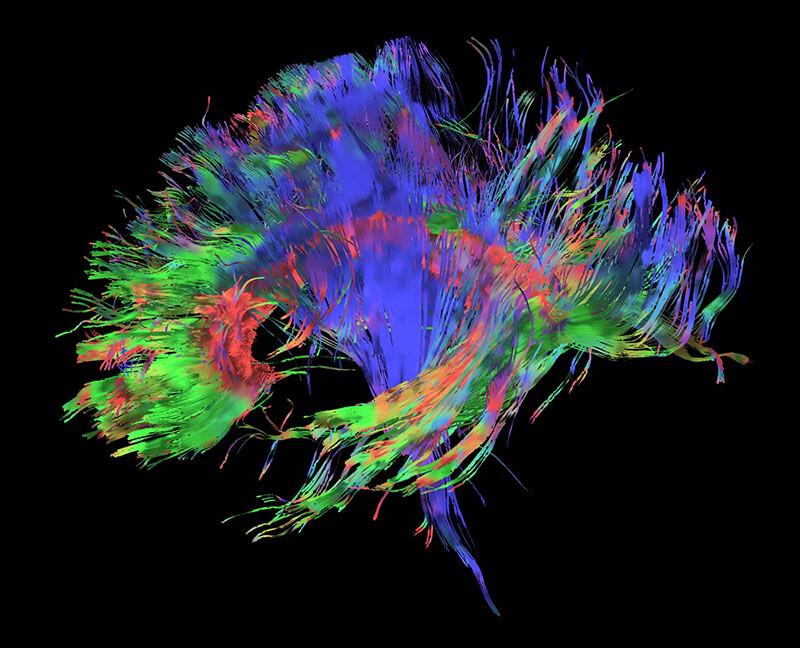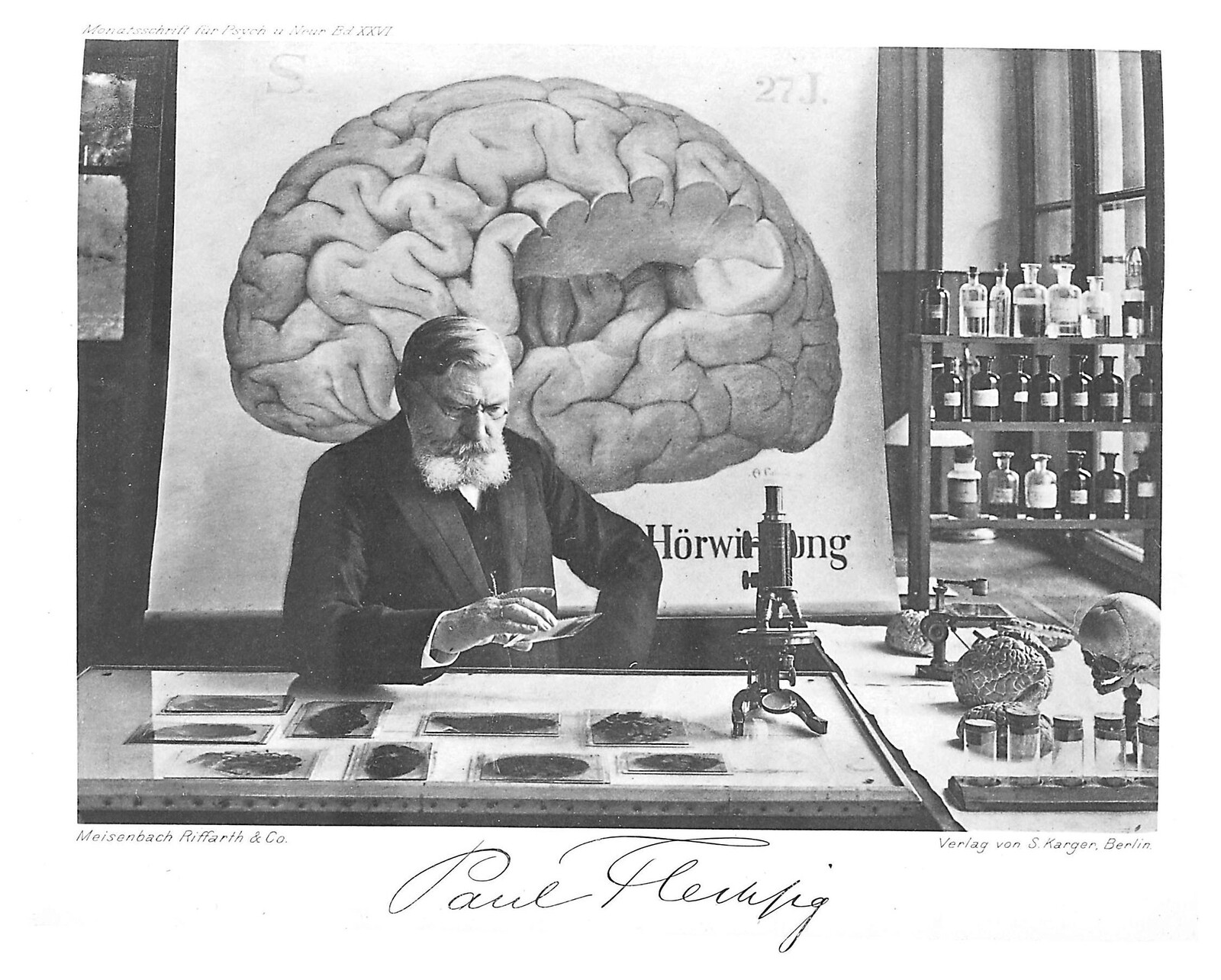1. Nervous Systems
In 1882 Doctor Paul Emil Flechsig, a brain anatomist with no experience in clinical psychiatry, took up the directorship of the psychiatric clinic of the University Hospital in Leipzig. For German institutional psychiatry, the appointment decisively inaugurated a new episteme. In one move, the era of the soul ended and the era of the brain began.1 Dr. Flechsig’s project linked neural activity to all of human behavior and thought, a reduction that persists in contemporary neuroscience. Despite substantial work done in order to resocialize and politicize neuronal contingency, materialist neuronormativity remains the dominant scheme for understanding the brain in today’s neoliberal neurosociety.2 This means that the discourses responsibly for interpreting the significance of the brain’s plasticity remain predominately mobilized towards individual enhancement, adaptation, and modification in the context of a neoliberal care of the Self, in contrast, for example, with the investment of the Italian autonomists in the political and emancipatory potential of the general intellect, as explored in the work of Antonio Negri and Paolo Virno.
Dr. Flechsig’s early experiments in the Leipzig clinic were among the first institutional attempts to bring the immortal spirit down to the level of physiology. Like his famous predecessor, the neuropathologist Theodor Meynert,3 Flechsig contended that psychiatry should be understood as nothing more than the treatment of diseases of the individual brain. All human actions were caused by scientifically explicable, objective truths that could be distilled from neuroanatomical data. This neuropsychiatric tradition of understanding mental illness as an objective and quantifiable entity—simply the illness of the nerves and the brain—was initiated by the neurologist Wilhelm Griesinger in the mid-nineteenth century.
From Griesinger to Meynert and Flechsig, neuropsychiatry did away with early-nineteenth-century Romantic psychiatry, which understood itself as the treating of the soul and which grew out of the pantheistic elements in Naturphilosophie. The challenge for Flechsig and others was to suture psychiatry to Naturwissenschaft (natural science), thus granting it the objective status of a true science, and with it the empirical authority over brain matter and the nervous system.
As we will come to see, this ultimately sets up a neuronal universality of the human within the white male ratio as the persistent figure of scientized humanism, a figure to be preserved at all costs. Here was born the individual as a complex system of information localization and transfer that could be rewired and reset using the right scientific and social programming. As the brain became the machine that pilots the human, an analogous pathway was laid for the future development of using machines to model the brain, which played out in the century that followed. Flechsig’s neuropathological paradigm marked the moment when the categories of incompleteness, incommutability, and unknowability begin to be generally understood not us a space of possibility and a terrain for a non-normative subjectivization, but as a threat and a source of social and political paranoia.
Given the significance of Flechsig’s work and its lineage, it is unsurprising that one of his patients, the judge Daniel Paul Schreber, became the most discussed and analyzed of all psychiatric patients, continuing to be relevant to both scientific and literary engagements with individual and collective paranoia. Schreber wrote an extensive first-person memoir where he described his nervous illness in great detail, in a style that merged methodical legal writing with the inspiration and literary flourish of a highly educated and sophisticated madman.
Since Denkwuerdingkeiten eines Nervenkranke, originally written to support Schreber’s release from a psychiatric asylum, was published in 1903 by Leipzig Verlag von Oswald Mutze—a publishing house with a penchant for spiritualism and evolutionary science4—it has been written about and analyzed by Freud, Benjamin, Lacan, Canetti, Deleuze and Guattari, and numerous others.5 In the text, Schreber claims that his two nervous illnesses both resulted, first, from the burden of unsuccessfully running for the Reichstag as the conservative/national candidate, and second, from being appointed the presiding judge (Senatspraesident) in Saxony’s highest court in Dresden. His mania came first from a struggle for political power and then again from assuming the position of highest legal and social authority.
During his first episode Schreber spent only six months at Flechsig’s clinic, and another six during his second, when he developed a complex system of paranoid delusions and hallucinations. He posited the existence of numerous gods feeding on his nerves, which he referred to as “fleeting improvised men.” He claimed to have developed a special relation with God, who had entrusted him with saving humanity after it had been destroyed. In the eight years he spent in the Sonnenstein asylum under Dr. Guido Weber (who also served as the expert witness in the Schreber case that was to decide whether the judge should be released or not), Schreber became convinced that Flechsig, who was interchangeable with one of the minor, nerve-feeding gods, was prosecuting him. His final delusion was that his nerves were attractive to God and that therefore his mission to renew humanity also required his becoming a woman in order to be penetrated and impregnated by the nerves of God. This mad-divine encounter would in turn give birth to a new humanity that would restore the “order of things” (Weltordnung). However, God, who in Schreber’s pathological paranoid system becomes the double of the anatomist Flechsig, only visits corpses (such as those on which Flechsig performed his neuro-anatomic research) and souls, but never the living. Schreber believed that an automatic recording system was in charge of narrating his accounts, and that this was also the guarantor of the absolute truth of his meticulously developed hallucinatory system.
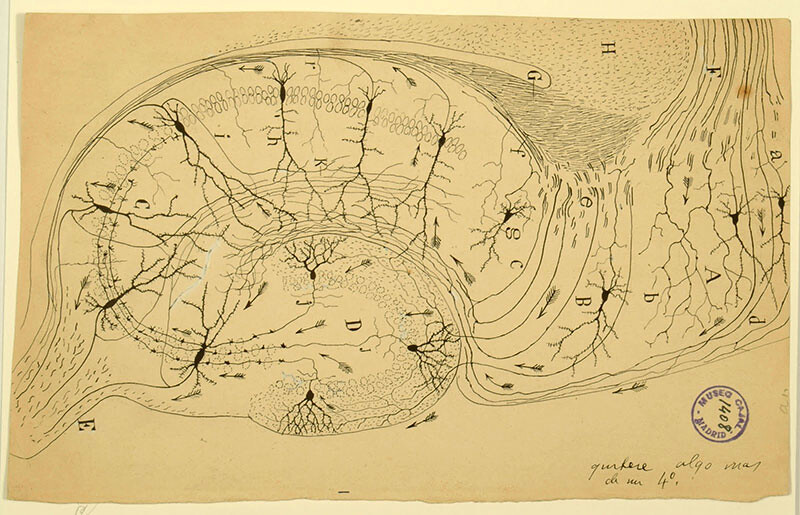

An early twentieth-century drawing by Spanish doctor Santiago Ramón y Cajal portrays how nervous tissue is structured in the hippocampus (Ammon’s horn) and the direction of the nerve impulse. Drawing, india ink on paper. Photo: Instituto Cajal (CSIC), Madrid.
The desire to conquer all the “unknown unknowns” of the human and make all aspects of the human fully accountable reverts to its properly religious heritage—the idea of an immaculate conception, a mating with God. The ideal of scientific completeness implicit in Flechsig’s materialist neuropsychiatry is explicitly articulated in the delusions of his most famous patient. It also underlies the social and political mathematics of one of his most (in)famous disciples, Emil Kraepelin—one of the most influential advocates of social Darwinism, eugenics, and racial hygiene as methods for preserving the purity of the German Volk. The projects of Flechsig and Kraepelin each participate in reducing the real to the rational in order to pursue the total capture of human life within the immanence of computability. Judge Schreber, on the other hand, is the late epitome of the Nietzschean madman. In her book Towards a Global Idea of Race, Denise Ferreira da Silva addresses the foundation of instituting (white) man as the universal Subject of knowledge in scientific projects dedicated to finding the “truth of man.” What she calls “the transparent ‘I’”—the universal Subject that possesses the means and tools to discover the truth—is the stronghold of Homo Modernus. Ferreira Da Silva opposes it to the “affectable I”—“the scientific construction of non-European minds.” In this light, Schreber, the pan-ultimate white European male madman, the product of Enlightenment Reason, is a warped mirror which confirms and professes from the inside of the “transparent I” that “that which falls prey to Reason by becoming it’s object has no place in the realm of Freedom.”6
In his contemporary appraisal of the relevance of Schreber’s case, Eric Santner situates the judge in the wider social aftermath of Bismarck’s Kulturkampf and the accompanying paranoias about cultural degeneration in the last decades of the nineteenth century. Santner reads Schreber’s testimony as an “investiture crisis”—a point of rupture when institutional protocols and symbolic orders “collapse into the most intimate core of one’s being.”7 Through both a psychoanalytic and historical materialist lens, such a collapse entails a complete “loss of distance to some obscene and malevolent presence that appears to have a direct hold of one’s inner parts,” generating anxieties not of absence but of extreme proximity.8 I would argue, in affinity with Santner, that it is necessary to understand this particular historical neurosis in order to identify a lineage of libidinal economy running from the totalitarian fascist regime that emerged in the decades after Schreber’s death, through the modern and postmodern forms of totalitarian rule and the collective paranoia of the Cold war, to the neoliberal world order that followed and the forms of technocratic postfascism we have witnessed in recent years across the Global North.
Schreber’s account of the relation between God, nerves, and truth is decisive for Santner in understanding the “theological dimension of political and social authority” in which paranoia is a form of knowledge concerning structural anomalies that malfunction in the “politico-theological procedures that otherwise sustain the very ontological consistency of what we call the ‘world.’”9 Here, Max Nordau’s diagnosis of ideological and cultural fatigue at the end of the nineteenth century, whereby symbolic values and forms lost their ontological base and credibility, is instructive. Accelerated technological development at this time was transposed into the realm of the personal: innovations such as steam and electricity penetrated so deeply into the life of every individual that they influenced the nervous system itself. It was, however, not merely this vertiginous technological development but its coinciding with the discovery of the laws of entropy that destabilized belief systems, optimism, and collective certainties so fundamentally.10 The very concept of social stability had to be refounded via a neuroscientifically reconstituted ideal of self-identical Enlightenment reason. It’s new location was the sphere of scientific medicine, which enabled, for the first time, the “nerves” of “objective” observation and inquiry to gain immediate access to the nerves of individuals. A vivid image of such direct nerve intrusion appears in the open letter that Judge Schreber addresses to Dr. Flechsig: “I have not the least doubt that the first impetus to what my doctors always considered mere ‘hallucinations’ but which to me signified communication with supernatural powers, consisted of influences on my nervous system emanating from your nervous system.”11 Undoubtedly, Schreber can be considered as his doctor’s negative, as suggested by Friedrich Kittler: where the scientist sees progress towards a new secular understanding of nature, the madman sees the intrusion of supernatural phenomena.12
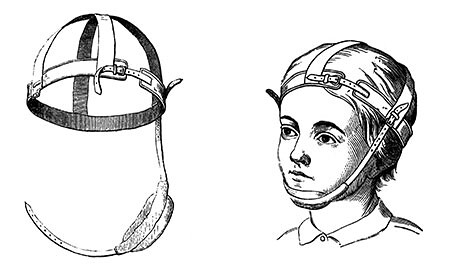

This orthopedic device was designed by Daniel Paul Schreber’s father, Moritz Schreber, to correct children’s posture.
And, of course, considered against our received understanding of nature, the progress of so-called “secular understanding” must be considered supernatural, epistemologically speaking, in order to be legible as progress at all. This is the contradiction, we might say, of modern science, which enthrones a secular idea of nature only to consistently overthrow it with the advent of newer paradigms. When Schreber explicitly accuses Flechsig of dispiriting him, of “soul murder” (Seelenmord), he is describing an actually existing tension between two “nervous systems” and a reduction of the complexity of human subjectivity and personhood to calculable anomalies. Even though Schreber describes this murder by drawing on the Faustian literary trope of the Devil claiming one’s soul, it is in fact with a local “God of science” and scientific inquiry that Schreber signs his fatal contract.
This should not surprise us, given that the Feuerbachian project of humanist essentialism proceeds by installing Man in God’s place but otherwise leaving its conceptual foundation in place. Like the Roman conquerors who replaced the heads on local totems with the visage of Caesar while leaving local rituals intact, the religion of humanism preserves the inherited, social relations of truth as it found them. Instead of an implacable, Abrahamic God, the symbolic effects of embodied, socially situated, and culturally lived subjectivity are now collapsed directly into sheer data, as the basis for a new regime of truth.
In the field of psychiatry epitomized by Flechsig, this transition meant the advent of the brain and matter as the loci of distortion. In Schreber’s case, this traumatic sequence is transferred into a hallucinatory vision of intruding nerves and develops into the specific operations of a “nerve language”: an automated writing-down-system (Aufschreibesystem),13 driven by a nerve(ous) automata lacking any conscious animating agency but still governing the flow of nervous energy in the universe. It is exactly this writing-down-system that ensures—by the very mechanical recording of the doings of nerves, dictated by the miraculous connection with an unbiased God—absolute proximity to truth. If we take Schreber at his word (as Freud did, at least when it suited him in supporting his own theories) in describing the mind as a complex information system orchestrated by the actions of the nerves, the truth that speaks through the automated nerve language is the truth of the disciplinary, monstrous classification regime Schreber was born into.14
If, as Freud says, the paranoiac discloses what the neurotic tries to hide, then Schreber’s paranoia—articulated to such systemic and imaginative degrees—becomes an oracle, unveiling, in all its clarity, the real of the turn of the century. “The real” here means that Schreber’s paranoia is in fact a traumatic rapture in the habitual language of the symbolic order of his time.15 The paranoid automatic writing-down-system sheds light on the moment when the fantasy of the complete (white male) subject is equipped with new means to become a next-level arbiter of truth, including in the control over life and death. Such a configuration of secular authority is accompanied by the immediately suppressed horror of recognizing that in his newly acquired position of the absolute sovereign, Man is the secular incarnation of Divine Law on Earth. In this light, Judge Schreber’s paranoia must be taken not only as the manifestation of a brutal extimacy (over-proximity to penetration by the nerves of God/Flechsig), but as a manifestation of the nervous breakdown of the white male subject of Enlightenment humanism, crushed in a moment of grasping its paradoxical double occupation: he is both the gatekeeper and author of the Law, and the sad penitent before it, a subject of eternal voluntary servitude, as described in Kafka’s famous parable.16 Here lies the uninterrupted and chilling continuity of the Schreberian double bind that leads to our age, in which the latest incarnation of totalitarian paranoia produced by the contemporary necropolitical apparatus of data positivism, profiling, and prediction creates its very own Aufschreibesystem.17 Similarly to Schreber, this one not only acts as the oracle of new truths but discloses the real of the regime behind it—the regime of an automated (data) totalitarianism.


In the Terminator franchise, here portrayed in its second iteration Terminator 2: Judgment Day, Skynet is a fictional neural net-based conscious system that serves as the main antagonist.
2. “Unknown Unknowns” and the Paranoid Apparatus
In Eric Santner’s words, “where there is a culture of paranoia, fascism of one kind or another may not be far behind.”18 At the very least, paranoia is a revealing symptom to follow, as it is structured as a disjunctive synthesis: it decomposes and breaks down into elements “the products of the condensations and identifications which are effected in the unconscious.”19 It is therefore unsurprising, even logical, that Schreber identifies with the male Arian that turns into all sorts of “lower beings,” among them a women and a wandering Jew (both connoting the horror of unmanning/Entmannung). Paranoia in this instance reveals “already fascisizing libidinal investment,” as Deleuze and Guattari have phrased it.20 In light of such a diagnosis, Schreber’s deliriums are in fact the emergent real of a hyperbolized “conspiracy theoretical” processing of the epistemic birth of the total apparatus, which will keep changing shape throughout the next century and on into the current one.
It goes without saying that the real history of this narrative was European imperialism, which constructed a white, masculine ideal of rational fullness and permanent progress as an ex post facto justification for the brutality of colonialism. Scientific racism, forged in the ruthless crucible of exploitation that was the New World, boomeranged back into the fold of History as fascist ideology. In such a trajectory, the expanded paranoid machine constructed in the aftermath of WWII was simply a continuation of the totalitarian techno-management of life and death suppressed by the “anti-ideology” of liberalism and by Pax Americana into the collective unconscious. The ideology of progress, the technological acceleration of totalitarianism, and the politicization of population management each found renewed and continuous expression in the paranoid scenarios of the Cold War. In a development parallel to this history of governmentality, the brain came to be considered a white male computer to be either fixed or reprogrammed. The repressed history of white male domination returned as a fantasy called “the computer,” an idealized model of a future white male brain that could, once again, be entrusted with piloting social, political, and economic life in the name of a stability that stubbornly refuses to arrive.
Today, it is the logic of data correlation and the extraction of meaning from activity-based intelligence that has became the dominant condition of possibility for the new automated Aufschreibesystem, one that increasingly exists independent of causal reasoning. In this scenario, life and death are subsumed into a system that could be said to suffer from an irreversible nervous paranoia. Every anomaly in the established data pattern triggers an alert for the nervous apparatus of prediction and control. It was Donald Rumsfeld, the Bush-era US Secretary of Defense, who infamously articulated this new categorical imperative in response to a question about the lack of evidence linking the government of Saddam Hussein to weapons of mass destruction: “As we know, there are known knowns; there are things we know we know. We also know there are known unknowns; that is to say, we know there are some things we do not know. But there are also unknown unknowns—the ones we don’t know we don’t know.” On the sticky surface of this paranoid, private, but simultaneously shared mental glue, a new kind of extimacy takes shape: the paranoid apparatus and the paranoid post-subject (the subject now reducible to data provider/user/composite cybernetic entity, arguably without agency) are in a constant over-proximity in a flattened space guided by the rule of the “quantifiable”—whether infinite or qualitatively complex. The only difference, of course, is how much data is available.
While vertically interconnecting systems of governmentality are able to construct complex paranoid mega-apparatuses, users are structurally reduced to the position of conspiracy theorists—visionary non-agents equipped with a false sense of having effectively mapped complexity. Ultimately, the universal, unconscious material paranoia of the data harvesters is reflected in the particular, oversensitive mania of the data providers. The imaginative faculty, its aptitude, is reduced to a claustrophobic sense that the world is already predetermined and that there exists a sacred code by which everything is connected, but in a way that can only be guessed at using mere cues and proxies. In such a scenario, artificial intelligence is often paranoically perceived as a kind of a new, self-governing Behemoth, which is, as we know from Schreber, merely the same old God of voluntary servitude to, and dependency on, phantasms of power and domination. If Flechsig, the brain anatomist, saw as the ultimate achievement of his work the “localization of categories of Kant’s transcendental idealism in the frontal lobe of the brain,”21 then certainly the present paranoia around the continuing accelerated development of AI captures the continuation of the desperate disfranchised imperialist search for the transcendental. When the absolute sovereign disappears as an addressable authority, the masters of the algorithmically enhanced Enlightenment cannot but keep either searching for it or attempting to construct it.
A recent incarnation of this paranoid principle can be found in an NSA surveillance program symptomatically entitled SKYNET.22 SKYNET is a machine-learning system that analyzes the metadata of 55 million Pakistani cell phones with the aim of detecting potential terrorist subject-threats. The Random Forest Algorithm behind the system functions similarly to a regular spam filter. For any spam filter to work optimally, it is essential that it be able to distinguish between known spam and known non-spam—the two categories form what is referred to as the system’s organizing “ground truths.” Distinguishing these enables the algorithm to correctly filter unwanted spam messages from that “old friend” or monarch in Nigeria or Indonesia who desperately needs your cash, for example. However, unlike the spam filter that is based on a substantial number of known (proven) spam messages, the SKYNET classification algorithm simply cannot operate with so many proven, “known terrorists” as the basis of its training set; it can only use already known messengers (of known terrorist organizations) to develop operational premises. An enormous quantity of collected cell phone metadata is read through these flawed, non-ubiquitous “ground truths” to generate a “potential terrorist” score for each individual device. The powerful, error-prone agency of the program is then transferred over to predator drones and death squads, which take care of executions on the ground. The ultimate product of this algorithmically driven procedure is thus a series of extrajudicial executions—a landscape of dead bodies and souls.
The unhappy congruence between the name given to this killer algo-program and the machine control depicted in the Terminator films’ wars between globalized AI (which operates through servers, drones, satellites, and cyborgs, such as the one personified by the famous Austrian bodybuilder and former governor of California) and humans is not coincidental. The self-authorizing, paranoid, “evil AI” that the techno-military complex named after apocalyptic fiction makes evident in a bigger picture the white male voluntary subjugation mechanisms’ phantasm of subjection: to be always in search of the transcendental nerves to penetrate and be penetrated by. Here (again), the machine and the brain are made out to be fully comparable communication systems, as famously analyzed by the Macy cyberneticians.23 The paranoid pulsating brain of the techno-military apparatus’ megamachine receives electric signals vibrating in constant and exaggerated proximity to its limbic extensions. The NSA’s SKYNET is thereby trusted as the unbiased Oracle of a future perfect, a new Schreberian paranoid machine whereby algorithmic extimacy discloses the real of emergent forms of data totalitarianism. The automated language of data harvesting, emptied of causality, is its actual Aufschreibesystem. If it is true, as psychoanalysis holds, that what is behind automation is the real, then what we are witnessing here is, perhaps paradoxically, quite the opposite from Friedrich Kittler’s view that the world of the machine is the world of the symbolic order. Here, the world of the machine becomes the world of the real.
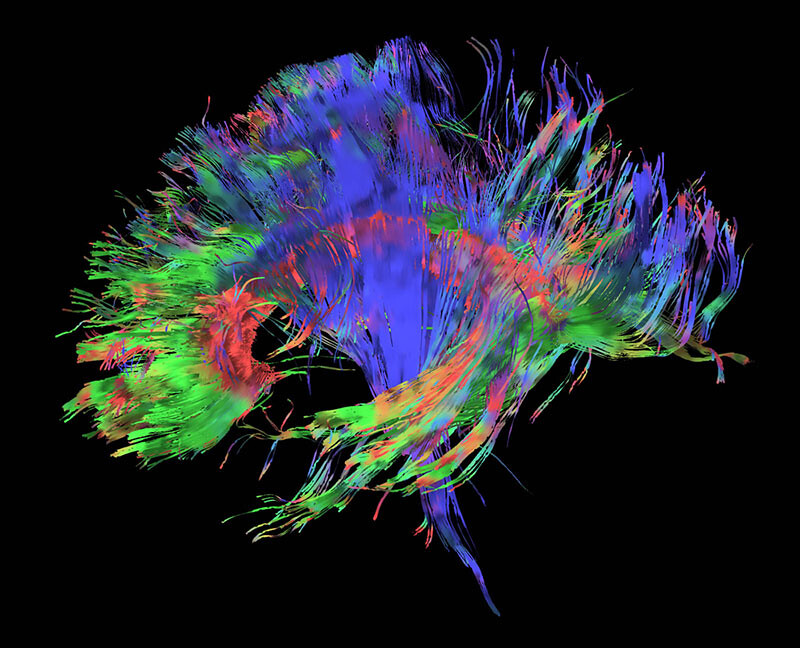

A high-throughput electrophysiology portrait of the brain from the Paul Allen Institute shows a living brain in action. Paul Allen was the co-founder of Microsoft along with Bill Gates.
3. Becoming Incomputable
In his 1965 book The Nerves of Government, Karl Deutsch introduced an approach to political analysis that applied Norbert Wiener’s concepts of feedback, channel capacity, and memory to social systems, consciousness, and social learning. By now, all the preconditions for the cybernetization of the social that Deutsch traced have been fulfilled: data-harvesting assemblages construct new totalitarian machines of capture; information is gathered and managed by correlation, and so on. The nerves of the new paranoid God of capture now exist, as in Schreber’s case, in a continuous uninterrupted connection with the nerves of its subjects. Deutsch also famously proposed that we think of political systems in terms of human brain operations—possessing, receiving, and processing nerves and managing information in order to generate responses. The crucial task, he contented, was understanding the conditions under which the nerves of the political systems and their apparatuses of capture become overloaded with incoming data and fail to convert these messages into adequate responses. The nervous breakdown of SKYNET, where flawed classification systems cause the deaths of thousands of innocents, would be just one candidate for such an analysis. The idea that technology is an extension of our central nervous system and, in fact, our consciousness, as proposed by Marshall McLuhan around the same time as Deutsch considered the social system as the brain and the nervous system, should thus be reversed. Haven’t we in fact become the extension of the central nervous system of the automated paranoiac megamachine that Schreber’s madness so brilliantly described?


Front cover of Karl Deutsch’s 1965 book The Nerves of Government.
In an attempt to capture his own nervous breakdown as the soul-murder that it was, Schreber lucidly understood the act of taking over a soul as having the aim of prolonging the taker’s own life, or securing some other benefits “which outlast death.” The other in the triadic structure that organizes the symbolic order of the militarized paranoid apparatus is thus fully comparable with Schreber’s God Flechsig, who prays on the nerves of corpses. Under conditions of total visibility, what might it mean to be more than “the android doubles we look like to those who, we think, control us,” as Lawrence Rickels has put it?24 We might entertain the question of whether Schreber’s image of his nerves pretending to be dead in order to start a new android race capable of replications beyond the drudgery of mortal reproduction and death is a hallucinatory premonition of our future survival options. Or should we rather, while keeping in mind Fredric Jameson’s claim that conspiracy theory is the “poor’s man critique of ideology,” dismiss such unhappy thoughts and embrace the android optimism of thinking that we encounter here a draft of a program for our future becoming inhuman,25 a sketch for an ever-expanding notion of human—a new, alien beginning of humanity that understands the human as never complete?
What would it mean to become incomputable, in affinity with the constituent incomputability that is part of the very logic of the machine? What would it mean to take both the machinic and human incompleteness seriously as a premises for a non-paranoiac politics and imagination? Might such an attempt also entail a struggle for the return of a reconfigured notion of the psyche, or an invocation of what Schreber calls “the soul”—that flawed protagonist of incompleteness and its unknown, contingent nature, embodied and situated, that died at the doors of Flechsig’s clinic?
Subjectivity bound to the white-male myth of humanism has always been a violent, impossible totalization. Embracing instead the flawed, unfinished incompleteness of the soul as the bearer of inhuman potential, as humanness unbound, is to enter the realm of the possible against the probable, a way of denying complete absolution to the data sovereign and its nerves of capture.26 It also means finally ceasing to be the creature that stands obediently and eternally in front of the gates of the Law, like Kafka’s pathetic man from the country, who dies waiting. The ontological heterogenesis once invoked by Deleuze means here not only alienating the naturalness of the human but also creating machines capable of constructing pathways for politicizing the collapse of the boundary between the world of matter and the hermeneutical world of the social Subject from a non-paranoid perspective. A political project of properly thinking with and through the machines and with and through the social brain needs a subject unbound to the voluntary servitude of either naturalist or transcendentalist provenance—in other words, it will have to be undertaken by a non-white, non-male subject of non-paranoid non-humanism conceptually and politically aligned with the incomputability in the machine itself.
Zvi Lothane, In Defense of Schreber: Soul Murder and Psychiatry (Hillsdale, NJ: Analytic Press, 1992, 205).
For an introductory overview of current discussions on the social brain vs. neoliberal neuromaterialism, see Charles T. Wolfe, “Brain Theory Between Utopia and Dystopia: Neuronormativity Meets the Social Brain,” in Alleys of Your Mind: Augmented Intelligence and Its Traumas, ed. Matteo Pasquinelli (Luneburg: meson press, 2015); and Victoria Pitts Taylor, “The Plastic Brain: Neoliberalism and the Neuronal Self,” Health, vol. 14, no. 6 (2010).
Some of Meynert’s famous students in Vienna were the Russian neuropsychiatrist Sergei Korsakoff and Sigmund Freud. One of Flechsig’s disciples, Emil Kraepelin, was one of the most influential advocates of eugenics and racial hygiene at the turn of the century.
The same publishing house released the work of Ernst Haeckel, a key figure in social Darwinism, who is discussed further below. His 1874 Anthropogenie—a book on embryology—had a significant role in Bismarck’s Kulturkampf, or “culture struggle,” of the 1870s.
For a good overview of what has been written on Schreber, see Lothane, In Defense of Schreber.
Denise Ferreira da Silva, Towards a Global Idea of Race (Minneapolis: University of Minnesota Press, 2007).
Eric Santner, My Own Private Germany: Daniel Paul Schreber’s Secret History of Modernity (Princeton: Princeton University Press, 1996).
Ibid., xii.
Ibid., xiii.
Ibid., 9.
Daniel Paul Schreber, “Open Letter To Professor Flechsig,” in Memoirs of My Nervous Illness (1903) (New York: New York Review Books, 2000), 8. Italics in original.
Referenced in Eric Butler, Metamorphoses of the Vampire in Literature and Film, Cultural Transformations in Europe, 1732–1933 (Rochester, NY: Camden House, 2010), 133.
Friedrich Kittler, whose seminal Aufschreibesysteme 1800/1900 (first edition: Fink: Munich, 1985) takes its name from Schreber’s system of “writing-down.” In his account of Schreber’s case, Kittler sees Flechsig’s psychophysical paradigm and Schreber’s writing as two poles of the new model of arranging the social and psychic sphere. Flechsig’s work marks the moment when personhood is replaced by an information system, thus preparing the ground for the emergence of new and more effective ways for power to intrude into the body as the object of investigation. “If psychophysics can explain its effects out of existence, then experimental subjects have no choice but open warfare and thus publication. Schreber writes to Flechsig in Flechsig’s language in order to demonstrate in the latter’s own territory that Schreber’s purported hallucinations are facts effectuated by the discourse of the Other. The Memoirs stand and fight in the war of two discourse networks. They constitute a small discourse network with the single purpose of demonstrating the dark reality of another, hostile one.” Friedrich Kittler, Discourse Networks, 1800/1900, trans. Michael Metteer, with Chris Cullens(Stanford, CA: Stanford University Press, 1990), 296–97.
Schreber’s father, Moritz Schreber, was a well-known educator and inventor of several uncanny correctional anatomical devices such as the Geradehalter, which made kids sit up straight at the table.
I am using the categories of the real, imaginary, and symbolic here quite crudely and without an absolute adherence and fidelity to how these appear in Lacanian psychoanalyses. I depart from the Lacanian triad in considering that the real is that which is beyond language and symbolization and which emerges only in moments of traumatic rupture, that the symbolic is primarily the domain of law and culture and the realm of its symbolic structures, and that theimaginary is that which relates to the illusion of totality, to fantasies of wholeness (of the image).
Franz Kafka’s “Vor dem Gesetz” (Before the Law) parable, originally published in 1915, appears in Der Prozess (1925). Available in English online →.
I borrow the term “necropolitics” from an eponymous article by Achille Mbembe (2003). Drawing on Foucault’s elaboration of the (sovereign’s) right to kill (droit de glaive), Mbembe contends that in the age of “war against terror,” the right to kill and the distribution of death become the dominant form of enacting sovereignty and power. Such necropower here connotes that the technologies of control, in the context of politics as war, actively exercise control over mortality. Mbembe’s point is that “the contemporary experiences of human destruction suggest that it is possible to develop a reading of politics, sovereignty, and the subject different from the one we inherited from the philosophical discourse of modernity.” Instead of considering “reason” as the truth of the subject we should rely on more tangible categories of life and death when discussing sovereignty in our times, in which the “state of exception and relations of enmity” have become the basis of the right to kill. Article available online →.
Santner, xiv.
Gilles Deleuze, Felix Guattari, Anti-Oedipus: Capitalism and Schizophrenia, trans. Robert Hurley(New York: Penguin Classics, 2009), 13.
“We can’t go along with Maud Mannoni when she sees the first historical act of antipsychiatry in the 1902 decision granting Judge Schreber his liberty and responsibility, despite the recognized continuation of his delirious ideas. There is room for doubting that the decision would have been the same if Schreber had been schizophrenic rather than paranoiac, if he had taken himself for a black or a Jew rather than a pure Aryan, if he had not proved himself so competent in the management of his wealth, and if in his delirium he had not displayed a taste for the socius of an already fascisizing libidinal investment.” Ibid., 364.
Santner, 71.
Christian Grothoff and J. M. Porup, “The NSA’s SKYNET program may be killing thousands of innocent people,” Ars Technica UK, February 2, 2016 →
The relation between brain, mind and the machine occurred persistently in the Macy conferences, as well as the problem of psychoanalysis and unconscious. The contestation between the position of “hard sciences” and “mentalist” perspectives of psychoanalysis and experimental psychology appeared repeatedly in the meetings. For example in the 7th conference (1950) L. Kubie’s lecture on neurosis and its relation to language and symbols triggered a debate in which Pitts and Bateson attacked psychoanalysis of not being a science since it was not based on any coherent theory or objectivity. Psychiatry in general was seen as unscientific. In the following conference, an influential collaborator of Norbert Wiener, the Mexican physician Arturo Rosenblueth suggested that neural events either happens or it does not, basically dismissing the category of the ‘unconscious’ altogether as nonsense and positing that natural sciences can handle all the problems conventionally addressed by psychiatry. In addition, Walter Pitts proclaimed that psychiatrists should be able to demonstrate that their methods are ‘scientific’. And while Pitts (who himself gave in to mental illness) and Warren McCulloch vigorously denied unconscious, Norbert Wiener believed that the discipline of psychoanalysis could productively be rethought in terms of communication and feedback. Lydia H. Liu for example, contends that psychoanalysis continued to “haunt” the cyberneticians (Liu: Freudian Robot. Digital Media and the Future of Unconscious, Chicago, University of Chicago Press, 2010). For a more general overview of Macy Conferences (interdisciplinary gatherings of academics and researchers held in New York Between 1946 and 1953, sponsored by the Josiah Macy, Jr. Foundation) see for example: Steve Heims: The Cybernetics Group, MIT Press, 1991 and Jean-Pierre Dupuy: The Mechanisation of Mind, MIT Press, 2009. For the transcripts of the 10 conferences see the recent Cybernetics: The Macy Conferences 1946-1953. The Complete Transactions. Ed. by Claus Pias, Zuerich: Diaphanes, 2015.
Laurence Rickels, I Think I Am: Philip K. Dick (Minneapolis: University of Minnesota Press, 2010), 68.
Reza Negarestani, “The Labor of the Inhuman,” in #Accelerate: The Accelerationist Reader, ed. Robin Mackay (London: Urbanomic, 425–466).
See the essay “The Paradigm of Incomputability” by Antonia Majaca and Luciana Parisi in an upcoming issue of the e-flux journal.
Subject
This essay was originally written for the volume Nervöse Systeme, edited by Anselm Franke, Stephanie Hankey, and Marek Tuszynski, for HKW - Haus der Kulturen der Welt and published by Matthes & Seitz, Berlin in January 2017.
